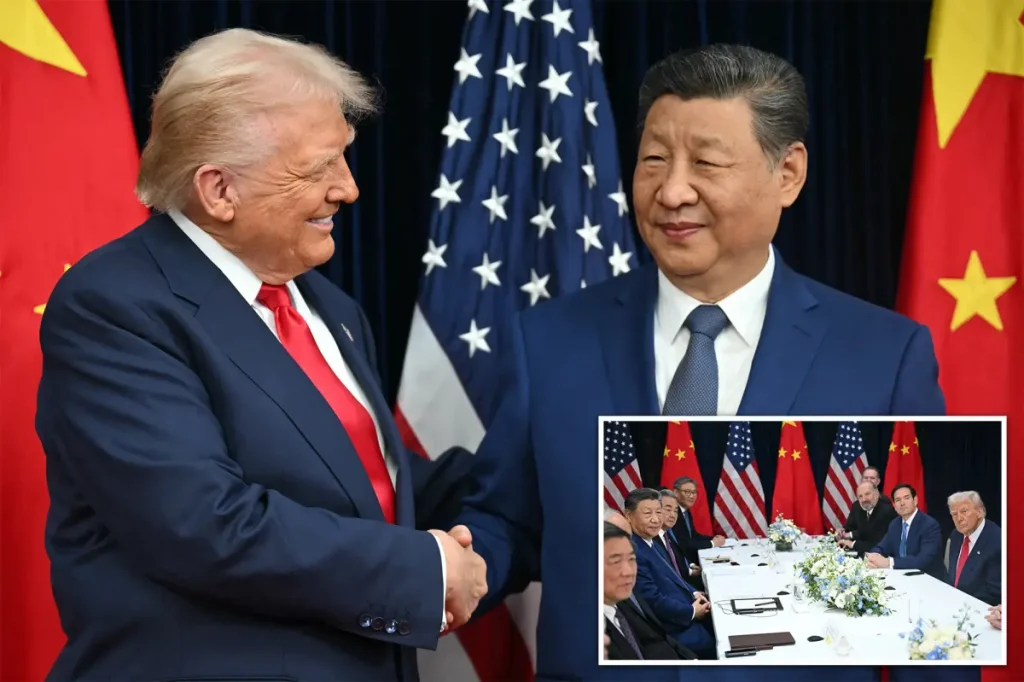Trump and Xi’s Pivotal Summit: A Promising Turn in US-China Relations
In a significant diplomatic moment that could reshape the trajectory of global economics and politics, President Donald Trump and Chinese President Xi Jinping met face-to-face for their first summit since Trump’s return to the White House. The meeting, held at a South Korean air base, marked a potential turning point in what has been nearly a year of escalating trade tensions between the world’s two largest economies. The atmosphere was notably warm and cordial, with both leaders expressing optimism about reaching what Trump called a “great understanding” to address the complex issues that have strained relations between Washington and Beijing. This meeting comes at a critical juncture when both nations are seeking to balance their competitive interests with the need for cooperation on matters of global significance.
The personal chemistry between the two leaders was immediately apparent, with Xi telling Trump it was a “great pleasure” to see him again as they shook hands for the first time in months. In a particularly notable moment that signaled China’s pragmatic approach to the relationship, Xi made a direct connection between China’s development aspirations and Trump’s signature “Make America Great Again” agenda, suggesting that the two nations’ goals need not be mutually exclusive. “China’s development goes hand in hand with your vision to make America great again,” Xi stated, followed by his insistence that “Our two countries are fully able to help each other succeed and prosper together.” This rhetoric represents a significant shift from the more confrontational tone that has characterized bilateral relations recently, with Xi emphasizing multiple times in public statements that “China and the United States should be partners and friends” rather than adversaries locked in a zero-sum competition.
The summit appears to have been built on substantial groundwork, with negotiators from both countries having reached what Xi described as “basic consensus” on major concerns during pre-summit talks in Kuala Lumpur, Malaysia. This preparation allowed the leaders to engage in nearly two hours of private discussions, focusing on practical steps to ease trade tensions that have sent ripples through the global economy. Trump acknowledged the challenges of negotiating with Xi, describing him as “a very tough negotiator,” but expressed confidence in a successful outcome. The Chinese leader, for his part, highlighted “encouraging progress” in recent consultations between economic and trade teams, while also praising Trump for his role in mediating conflicts in other regions – a diplomatic gesture acknowledging the American president’s influence on the world stage.
The framework understanding emerging from the summit appears to address several contentious issues that have fueled tensions between Washington and Beijing. Most significantly, Trump indicated his intention to reduce the 20% tariffs he imposed on Chinese goods over fentanyl concerns, while suggesting he’s unlikely to follow through on threats of implementing a 100% additional tariff related to Beijing’s export restrictions on rare-earth minerals and other critical materials. These punitive measures had become major sticking points in bilateral trade, with American businesses and consumers bearing significant costs from the tariff war. The willingness to reconsider these tariffs represents a pragmatic recognition by the Trump administration that economic de-escalation serves American interests, particularly as the president seeks to fulfill campaign promises to lower inflation and strengthen the domestic economy.
In response to these American concessions, China appears ready to make several meaningful commitments of its own. Beijing is expected to suspend for one year its controversial export restrictions on products made with rare-earth and critical minerals – materials essential to advanced manufacturing, including defense technologies and electric vehicles. Perhaps more consequentially from a humanitarian perspective, China has pledged to intensify its crackdown on fentanyl smuggling – a synthetic opioid that has devastated American communities, killing approximately one in every 1,000 Americans over the past five years according to federal data. The fentanyl crisis has become not just a public health emergency but a significant point of diplomatic friction, with American officials long pressuring China to take stronger action against illicit production and trafficking of the deadly substance.
Beyond these specific measures, the summit appears to have opened pathways for renewed agricultural trade – a sector that has experienced significant disruption during the trade disputes. China is expected to commit to resuming purchases of American soybeans, which had been heavily targeted with retaliatory tariffs in response to Trump’s fentanyl-related levies imposed in February. This agricultural aspect of the agreement would bring particular relief to American farmers, who have weathered severe economic impacts from lost access to the massive Chinese market. While the framework understanding reached at this summit represents just the beginning of what will likely be a complex process of trade normalization, the constructive tone and concrete commitments from both sides suggest a mutual recognition that cooperation, even amid competition, serves the interests of both nations and the broader international community. The path forward remains challenging, but this meeting may well be remembered as the moment when the world’s two most powerful nations chose pragmatism over escalation.









